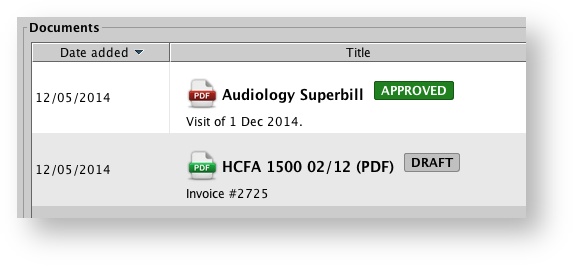- Created by Former user, last modified by Bridget Fritzke on Dec 15, 2015
You are viewing an old version of this page. View the current version.
Compare with Current View Page History
« Previous Version 29 Current »
Voiding invoices
- On the Patient browser tab, open the patient’s file.
- Click the Sales history tab.
Right-click a sale and select Void invoice.
- In the confirm operation dialog box, do one of the following:
- Click Yes. All patient payments and credits will be unapplied, and patient write-offs applied to the sale deleted.
Click No to cancel the void.
QuickBooks
Voided invoices are recorded in QuickBooks.
The Void invoice option is only available for quick sale items such as batteries, services, and accessories. To reverse a sale of hearing aids, process a return.
Writing off invoices
- On the Patient browser tab, open the patient’s file.
- Click the Sales history tab.
- Right-click an open sale allocated to a patient, indicated by a warning icon within the Debit column, and select Write off.
- On the Create credit screen, enter the write off amount in the Credit amount field beside the desired item.
- To save the change, click out of the cell, or click Enter on the keyboard.
Click Create.
QuickBooks
Patient write offs are recorded in QuickBooks as credit memos.
The Write off option is only enabled on open invoices with a non-zero balance.
Viewing transaction history
- On the Patient browser tab, open the patient’s file.
- Click the Sales history tab.
Right-click an item and select Transaction history.
The Transaction history dialog box displays a list of payments, credits, refunds, and/or invoices applied against the specific transaction.
Editing prescriber/fitter details
- On the Patient browser tab, open the patient’s file.
- Click the Sales history tab.
Right-click a hearing aid sale and select Prescriber/fitter details.
Click into the Prescriber and/or Fitter field across from the desired hearing aid to select a different name from the drop-down menu.
The list of prescribers includes all users who have the role Audiologist or Specialist, as well as any external prescribers who may refer patients and are listed as a referral source within the Audiologist referrer type. The list of fitters includes all users who have the role Audiologist, Specialist, or Dispenser. See: Setting up roles and users for more information.- Click UPDATE.
Printing invoices
- On the Patient browser tab, open the patient’s file.
- Click the Sales history tab.
Right-click an item and select Print.
Use the save or print icons in the top, left-hand corner to save or print the payment receipt, invoice, and/or credit memo. Click ARCHIVE to save a copy to the patient's Documents tab.
Generating insurance claim forms (United States)
- On the Patient browser tab, open the patient’s file.
- Click the Sales history tab.
Right-click a sale and do one of the following:
Select HCFA 1500 02/12. In the Enter report parameters dialog box, select the ICD indicator and enter/adjust Diagnosis codes as needed. Click Ok.
Each field name has a corresponding value. Double-click in the value field to update the field, click out of the cell to save the change, and click Update.Select HCFA 1500 02/12 (PDF). This HCFA form can be edited directly on the screen by clicking into the desired field, updating as necessary, and clicking out of the cell or Enter on the keyboard, to save the change.
Complete insurance information in the patient's Insurers tab must be present, along with a provider specified on the invoice, for the HCFA 1500 02/12 option to be available. ICD codes populate from saved data in the patient's Audiology tab.
ICD codes populate from saved data in the patient's Audiology tab.
Click ARCHIVE to save the document in the patient's Document tab. The category of the document is automatically set to Insurance claim, and the description is automatically filled with the invoice number. In patient's Document tab, editable PDF documents are indicated with a green PDF icon, and can be opened for editing by double-clicking on the document. When saving changes to an editable PDF, choose one of the following options in the Editable form options dialog box:
- Yes, allow future editing.
- No, lock the form now. Locked documents are indicated with the standard red PDF icon.
- Cancel.

Generating insurance claim forms (Canada)
The following insurance claims forms are available in the patient's Sales history tab:
- DVA/VAC
- NIHB
- ADP
- NIHL Trial Period
- NIHL Assessment
- NIHL Rehabilitation
- WCB AB C659
- WCB AB C660
- WCB AB C972
- AADL FM Validation Certificate
- AADL FM Service Certificate
- AADL HA Validation Certificate
- AADL Repair/Earmold Service Certificate
- WCB BC 51D12
The following insurance claim forms are available by right-clicking an assessment date in the patient's Audiology tab.
- COSI
- WCB AB C662
- WCB BC 83D73
- On the Patient browser tab, open the patient’s file.
- Click the Sales history tab.
Right-click a sale, and select the desired claim form.
Searching on item name and Txn ID
- On the Patient browser tab, open the patient’s file.
- Click the Sales history tab.
Click on a transaction and begin typing all (or part) of the desired text or Txn ID search string. The search will jump to the first matching entry.
The wildcard (*) character may be used to match any sequence of characters.- Use the up and down arrow keys to navigate through the list of matches.
-
Page:
-
Page:
-
Page:
-
Page:
-
Page:
-
Page:
-
Page:
-
Page:
-
Page:
-
Page:
-
Page:
-
Page:
-
Page:
-
Page:
-
Page:
- No labels